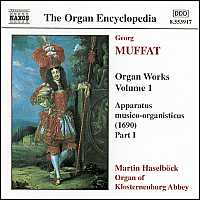Georg Muffat is credited with the unification of the musical styles of Italy, France and Germany during the 17th century. As a boy he was sent to Paris to study music, the great Lully among his distinguished mentors. His return to his family in Alsace was ended by the threat of imminent war, and he fled to Vienna. Emperor Leopold I became his patron.
Granted leave to go to Italy, he was greatly influenced by Corelli, and on his return to Germany wrote the orchestral suites, Florilegia, considered among the finest works written in Germany in the second half of the 17th century.
Muffat presented the Apparatus musico-organisticus to Emperor Leopold who accepted its dedication. The book contained an organ score of considerable importance, the main section comprising twelve large-scale Toccatas arranged in the order of church tones, each work constructed in several sections to display the brilliance and extremes of organ textures.
